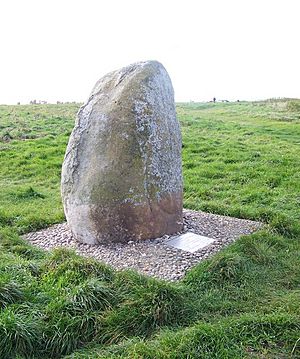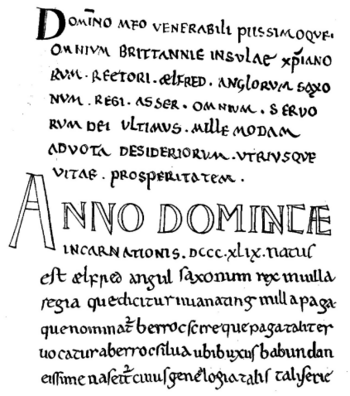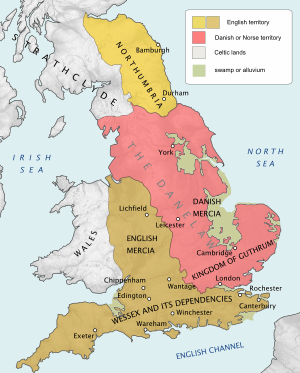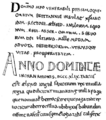Battle of Edington facts for kids
Quick facts for kids Battle of Edington |
|||||||
|---|---|---|---|---|---|---|---|
| Part of the Viking invasions of England | |||||||
 Memorial to the Battle of Ethandun erected in 2000 near the hillfort of Bratton Castle. |
|||||||
|
|||||||
| Belligerents | |||||||
| Wessex | Danelaw | ||||||
| Commanders and leaders | |||||||
| Alfred the Great | Guthrum | ||||||
| Strength | |||||||
| 2,000–6,000 | ~4,000 | ||||||
| Casualties and losses | |||||||
| unknown | 2,000+ | ||||||
The Battle of Edington was a very important fight in English history. It happened in May 878. In this battle, the army of the kingdom of Wessex, led by Alfred the Great, defeated the Great Heathen Army. This Viking army was led by a Dane named Guthrum. The victory led to the Treaty of Wedmore later that same year. This treaty helped shape the future of England. Historians believe the battle took place near the village of Edington in Wiltshire. It is also sometimes called the Battle of Ethandun.
Contents
Why did the Battle of Edington happen?
Early Viking Raids in England
The first Viking attack on Anglo-Saxon England probably happened between 786 and 802. Three Norse ships arrived at Portland in the Kingdom of Wessex. Their men killed a local official called a reeve. In 793, Vikings also raided the holy island of Lindisfarne in the north.
"This year dire forwarnings came over the land of the Northhumbrians, and miserably terrified the people; these were excessive whirlwinds, and lightnings; and fiery dragons were seen flying in the air. A great famine soon followed these tokens; and a little after that, in the same year, on the 6th before the Ides of January, the ravaging of heathen men lamentably destroyed God's church at Lindisfarne through rapine and slaughter."
After Lindisfarne, Viking raids were not constant until the 830s. Then, attacks became much more frequent. In 835, "heathen men" attacked Sheppey. In 836, Ecgberht of Wessex fought a force of 35 Viking ships at Carhampton. In 838, he faced Vikings and Cornishmen together at Hingston Down in Cornwall.
The Arrival of the Great Heathen Army
The raids continued and grew stronger each year. In 865–866, things changed a lot with the arrival of the Great Heathen Army. The old records do not say how big this army was. But experts today think it had between 500 and 1,000 men. It was supposedly led by three brothers: Ivar the Boneless, Ubba, and Halfdan Ragnarsson. This army was different because its leaders wanted to conquer and settle, not just raid.
By 870, the Vikings had conquered the kingdoms of Northumbria and East Anglia. In 871, they attacked Wessex. Out of nine battles that year, the West Saxons won only one. In 871, Alfred became king after his brother Ethelred died.
Guthrum's Attacks on Wessex
The kingdom of Mercia fell by 874. The Great Heathen Army then split up. Halfdan went back to Northumbria and settled there. He fought the Picts and the Strathclyde Welsh to protect his northern kingdom. Guthrum, with two other kings, went to Cambridge in East Anglia.
Guthrum started attacking Wessex in 875. In his last attack, he almost captured King Alfred in his winter base at Chippenham. By 878, the Danes controlled the east and northeast of England. Their defeat at the Battle of Ashdown had slowed them down but not stopped them.
King Alfred the Great spent the winter before the Battle of Edington hiding. He was in the Somerset marsh of Athelney. This area was naturally protected by the swamps. In the spring of 878, he called his West Saxon forces together. He marched to Edington, where he met Guthrum's Danes in battle.
What was Alfred's situation before the battle?
Guthrum and his men often used a trick. They would take over a fortified town and then offer a "peace treaty." This treaty usually involved Alfred paying them money to leave the kingdom. Alfred would follow the army, trying to stop them from causing more damage. This started in 875 when Guthrum's army got into Wareham. They gave Alfred hostages and promised to leave, and Alfred paid them.
But the Danes quickly went to Exeter, even deeper into Alfred's kingdom. There, in late 877, they made another "firm peace" with Alfred. They promised to leave his kingdom and not come back. They spent the rest of 877 in Gloucester (in Mercia). Alfred spent Christmas at Chippenham (in Wessex), about 30 miles (48 km) from Gloucester.
The Danes attacked Chippenham in midwinter, probably on the night of January 6–7, 878. They captured Chippenham and forced Alfred to retreat "with a small force" into the wild areas. (This is when the famous story of Alfred burning the cakes is said to have happened.)
At this time, Alfred seemed to be chasing the Danes without much success. The Danes were able to do what they wanted. The old records try to make it seem like Alfred was in control. But it was hard for him to fight the Danes in open battle. His army could not even defend the fortified town of Chippenham. Between 875 and late 877, Alfred could do little but keep paying the invaders to leave.
The Battle of Edington

After the disaster at Chippenham, Alfred was next seen around Easter 878. He built a fortress at Athelney. In the seventh week after Easter, between May 4 and 7, Alfred called for his army to gather at Ecgbryhtesstan (Egbert's Stone). Many men from the nearby counties like Somerset, Wiltshire, and Hampshire joined him there.
The next day, Alfred's army moved to Iley Oak. The day after that, they marched to Eðandun. There, on a date between May 6 and 12, they fought the Danes. According to an old book about Alfred's life:
"Fighting ferociously, forming a dense shield-wall against the whole army of the Pagans, and striving long and bravely...at last he [Alfred] gained the victory. He overthrew the Pagans with great slaughter, and smiting the fugitives, he pursued them as far as the fortress."
After the victory, the Danes ran into their fortress for safety. The West Saxons then removed all food from the area. This stopped the Danes from getting supplies if they tried to leave the fortress. After two weeks, the hungry Danes asked for peace. They gave Alfred hostages and promised to leave his kingdom right away. They also promised that Guthrum would be baptized as a Christian.
This agreement was different from earlier ones. Alfred had truly defeated the Danes at Edington. This made it more likely that they would keep their promises.
Alfred's victory was probably due to the size of the armies. The men from even one shire (a county) could be a strong fighting force. The people of Devon proved this in the same year. They defeated a Viking army led by Ubba at the Battle of Cynwit. Also, by 875, Guthrum had lost the support of other Danish leaders like Ivar the Boneless and Ubba. Many other Danish forces had settled in England before Guthrum attacked Wessex. Many Viking ships were also lost in a storm off Swanage in 876–877. The Danes were having problems among themselves and needed time to get organized. Luckily for Wessex, they did not use this time well.
Where did the battle take place?

The main old writings about the battle's location are Asser's Life of King Alfred and the Anglo-Saxon Chronicle. Asser's book calls the place "Ethandun." The Anglo-Saxon Chronicle calls it Eðandun. The Chronicle was written during Alfred's time, so it is a very old record. Asser's book was likely written around 893. However, no original copies exist today.
Most historians today agree that the battle happened at Edington, near Westbury in Wiltshire. But people have argued about the exact spot for hundreds of years. In 1904, William Henry Stevenson studied possible sites. He said there was "little reason for questioning" that Edington in Wiltshire was the correct place.
The reason for choosing Edington, Wiltshire, comes from old documents. Edington, Wiltshire, was part of Alfred's family land. He left a manor called Eðandun to his wife in his will. An old record shows a meeting of the king's council at Eðandun. In 968, another record said King Edgar gave land at Edyndon to Romsey Abbey. The Domesday Book of 1086 also mentions Romsey Abbey holding land at Edendone in Wiltshire. This is known to be Edington, Wiltshire.

Over the years, other places have been suggested for the battle site. For example, the Tudor historian Polydore Vergil thought it was at Abyndoniam (Abingdon). In the 1800s, people became very interested in King Alfred. Many tried to find Alfredian sites or suggest new places for the battle. These ideas were often based on similar-sounding names. Also, any site linked to Alfred could attract many tourists.
What happened after the battle?
Three weeks after the battle, Guthrum was baptized at Aller in Somerset. Alfred himself was Guthrum's sponsor. Alfred may have wanted Guthrum to become Christian. He hoped this would make the Danes follow any peace treaties more seriously. Guthrum took the baptismal name of Athelstan.
Under the Treaty of Wedmore, Guthrum had to leave Wessex and go back to East Anglia. So, in 879, the Viking army left Chippenham. They went to Cirencester (in the kingdom of Mercia) and stayed there for a year. The next year, the army went to East Anglia and settled down.
Also in 879, another Viking army sailed up the River Thames. They spent the winter at Fulham in Middlesex. Over the next few years, this Danish group had several fights with Alfred's forces. But Alfred managed to control this threat. He did this by improving his army and building a system of fortified towns called burhs.
In 885, the Viking army in East Anglia broke the peace they had made with Alfred. Guthrum was not mentioned as being involved. Guthrum ruled as king in East Anglia until he died in 890. Even though this time was not always peaceful, he was no longer seen as a threat to Alfred.
In 886, the Treaty of Alfred and Guthrum set the borders between their two kingdoms. The kingdom of Mercia was split. Part went to Alfred's Wessex, and part went to Guthrum's East Anglia. The agreement also set out the social rules for both peoples. It aimed to reduce fighting and control trade between them.
It is not clear how seriously Guthrum took his Christian conversion. But he was the first Danish ruler in England to make coins like Alfred's. He used his Christian name, Athelstan, on them. By the end of the 800s, all Anglo-Danish rulers were making coins this way. By the 900s, the Anglo-Saxon way of kingship seemed to be adopted by the Anglo-Danish leaders.
After Guthrum's defeat at Edington, Alfred made changes to his army. This made it harder for Vikings to raid successfully. By 896, the Vikings had given up. Some went to East Anglia, and others went to Northumbria. It was Alfred who finally contained the Viking threat. His military changes and the Burghal Hidage system helped his successors. These changes allowed them to take back control of the lands in the North of England that the Danes had taken.
Images for kids
-
King Alfred's Tower (1772) at a possible site of Egbert's Stone, where Alfred's army gathered.
-
A 1722 copy of part of Asser's Life of King Alfred.
-
An extract from the Domesday Book showing Edington as Edendone.




